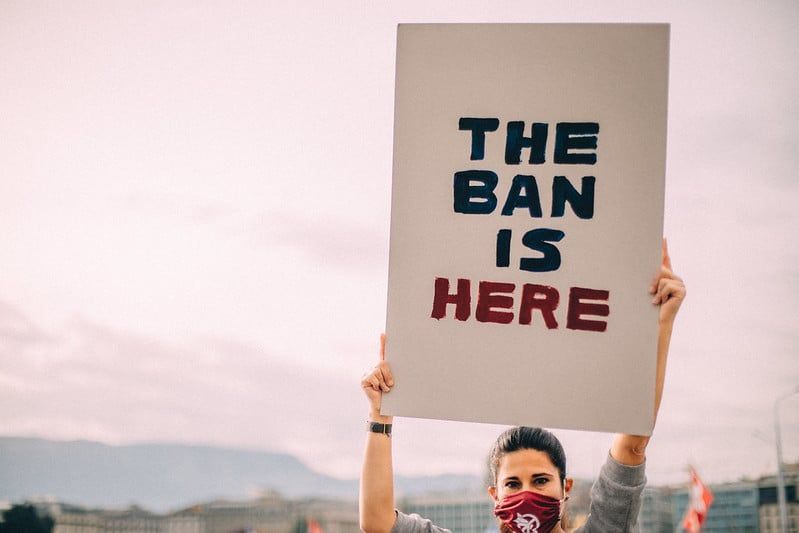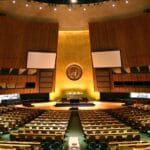Turn back the Clock: The nuclear ban treaty is entering into force
By Talei Luscia Mangioni, Alicia Sanders-Zakre | January 22, 2021
 Photo courtesy ICAN
Photo courtesy ICAN
It’s time to turn back the clock.
Last year, the Bulletin of the Atomic Scientists announced that the Doomsday Clock would be set at 100 seconds to midnight because humanity faced the dual existential perils of nuclear war and climate change, exacerbated by the emergence of cyber-enabled information warfare. While this announcement did not account for the chaotic remainder of the year, which included the COVID-19 pandemic and a volatile Trump presidency, one historic milestone for nuclear justice took place adjacent to the chaos of last year. On Oct. 24, 2020, the Treaty on the Prohibition of Nuclear Weapons (TPNW) received its fiftieth instrument of ratification, triggering its entry into force on January 22 of this year. The treaty’s entry into force is a significant step to reduce the threat of nuclear disaster. It should be recognized as such when the Science and Security Board of the Bulletin of the Atomic Scientists sets the time of the 2021 Doomsday Clock.
The TPNW is the first treaty to categorically ban nuclear weapons and provide a pathway for all nations to outlaw and eliminate those weapons. While some critics are quick to dismiss the impact of the treaty, its entry into force will lead to concrete changes to reduce nuclear risks, as early as this year. The treaty now has been signed by 86 countries, 51 of which have also ratified or acceded to it. The treaty’s entry into force requires state parties—that is, countries that have signed and ratified or acceded to it—to implement specific treaty obligations starting January 22. (Countries that have signed but not ratified or acceded to the treaty must refrain from violating its general “object and purpose.”)
States party to the ban treaty must abide by its Article 1 prohibitions, which prohibit them from developing, testing, producing, manufacturing or otherwise acquiring, possessing or stockpiling, using or threatening to use nuclear weapons or allowing nuclear weapons to be stationed on their territory. Article 1 also prohibits them from assisting, encouraging or inducing anyone to engage in these activities. These prohibitions represent new international legal obligations for states parties restricting nuclear activities. Although many TPNW states parties are already party to nuclear-weapon-free zones that prohibit some of these activities, these regional treaties are limited in geographic scope and do not necessarily include all of the TPNW prohibitions. A few TPNW states are not party to a nuclear-weapon-free zone at all.
In addition, parties to the treaty must take active steps to implement it. All parties are required to make a declaration of their nuclear-weapon status, maintain International Atomic Energy Agency standard safeguards, and negotiate and implement a comprehensive safeguards agreement if they don’t already have one. All state parties must adopt national measures to prevent and suppress any violations of the treaty by people or territory under its control. These obligations include groundbreaking new provisions to provide assistance to victims under their jurisdiction who have been impacted by nuclear weapon use and testing as well as take appropriate measures to address the need for environmental remediation of areas contaminated by nuclear weapon use and testing. Finally, state parties must cooperate with other states to implement the treaty, including helping to provide victim assistance and conduct environmental remediation.
As countries that are party to the treaty implement their obligations under it this year, their actions will have ripple effects that will reach countries that are not party. Most directly, countries that haven’t joined will be subject to additional calls to join and comply with the treaty’s prohibitions from states parties, in bilateral meetings or in international forums. The implementation of the treaty and its institutionalization will also serve to further stigmatize nuclear weapons on the international stage, leading to concrete changes in countries not party. After the entry into force of the landmine and cluster munitions ban treaties, for example, some companies producing these weapons in states not party to the treaties stopped making them; some financial institutions stopped investing in companied that produced landmines and cluster munitions; and some countries changed policies on use and transfer of those weapons.
Later this year or early in 2022, states parties, signatories, observer states, and civil society groups will convene to create a plan for the full implementation and universalization of the treaty. Since the adoption of the treaty, researchers around the world have published papers on how to implement its obligations, from setting a deadline for the elimination of nuclear weapons, to verifying the removal of nuclear weapons, to establishing programs to assist victims of nuclear weapons use and testing. In preparation for the first meeting of states parties, researchers will conduct and produce more material on these crucial questions to advance nuclear disarmament.
The entry into force of the Treaty on the Prohibition of Nuclear Weapons is a development that the Doomsday Clock cannot afford to ignore. Despite the resistance of nuclear-armed states and a couple dozen of their allies—and their attempts to pressure other countries into submission—the TPNW has garnered global support. Built on decades of nuclear disarmament advocacy, the treaty has been led by the true experts of nuclear weapons, the survivors of nuclear weapons use and testing. The treaty recognizes nuclear weapons for what they are—unacceptable instruments of mass destruction—and acknowledges their disproportionate impact on indigenous communities. Failing to acknowledge the positive impact of the TPNW entering into force in 2021 for international peace and security is a failure to recognize the leadership of the 122 countries and civil society who pushed for its adoption and who will continue to work for its full universalization and implementation. On January 27, the Bulletin of the Atomic Scientists Science and Security Board should recognize the important contribution of this treaty and its global supporters in reducing nuclear risk in its setting of the Doomsday Clock.
Together, we make the world safer.
The Bulletin elevates expert voices above the noise. But as an independent nonprofit organization, our operations depend on the support of readers like you. Help us continue to deliver quality journalism that holds leaders accountable. Your support of our work at any level is important. In return, we promise our coverage will be understandable, influential, vigilant, solution-oriented, and fair-minded. Together we can make a difference.
















